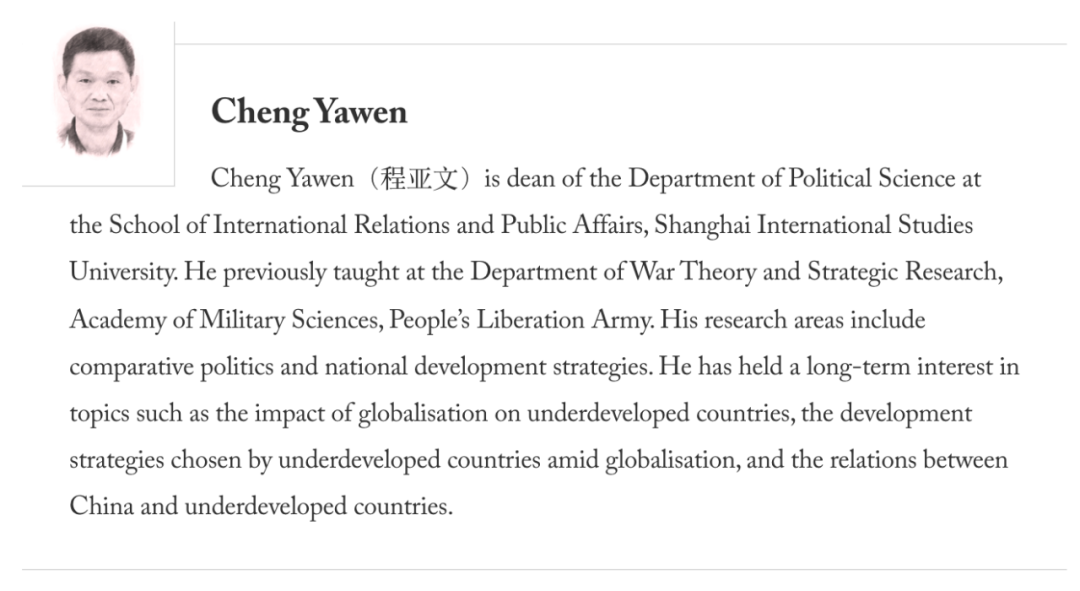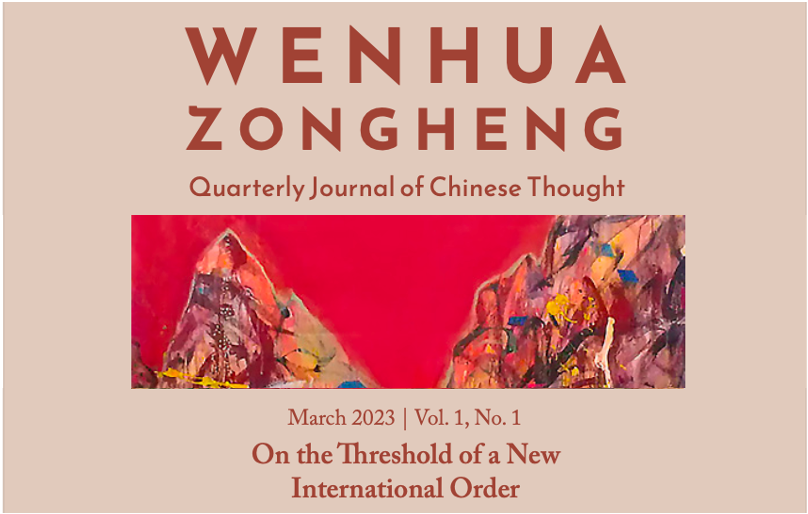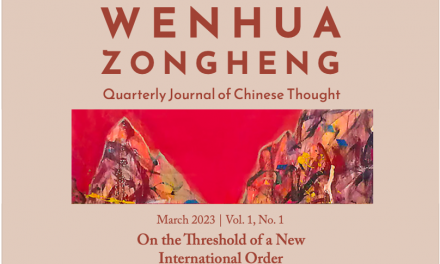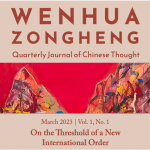Building the New ‘Three Rings’: Reconfiguring China’s Foreign Relations in the Face of Decoupling

The ‘special military operation’ launched by Russia against Ukraine, along with the attendant stalemate that has set in between the West and Russia, are landmark events that signal the approaching end of the globalisation wave that began in the 1980s. The absurd efforts of the United States to bully its allies into enacting murderous sanctions against Russia and to browbeat other countries into taking sides in this conflict, have brought the world to a state reminiscent of the deadly global struggles of the twentieth century ago. These developments pose a major challenge to China; the end of this wave of globalisation means that the country will no longer have the same external environment for development that it has enjoyed for the past forty years, and that the US will likely intensify its push to re-establish its domination over the international system and to decouple from China and Russia. The world has undergone a paradigm shift.?In the face of a potential forced and complete decoupling from the United States and Western countries, China must take initiative and adjust its foreign strategic orientation, reprioritising the countries that it engages with in order to develop a new international order that would safeguard against the repercussions of this decoupling.
The Unspoken Rule of the International Order: The Centre-Periphery Power Structure
During the three decades since the collapse of the Soviet Union, relations between Russia and the West have vacillated. Initially, Russia pursued friendly ties with the US and Western countries, then it gradually grew apart from them, and now it has entered into a fierce confrontation. The evolution of this relationship reflects the political limits of globalisation. Unlike the romantic notions of globalisation that were ascendant following the end of the Cold War, in reality, this era saw the establishment of US hegemony and the dismemberment of the Soviet Union and the socialist camp. This process of globalisation and the US pursuit of global supremacy are two sides of the coin; they condition and promote each other. The inability of this system to promote international equality, with developed and developing countries locked into a relationship of dominator and follower states, means that it cannot continue endlessly. On the one hand, globalisation is abandoned, reversed, or redesigned when it backfires on its initiators, threatening their superiority; on the other hand, countries will continue to resist when powerful states relentlessly pursue domination.?Russia’s special military operation against Ukraine was the result of the domineering nature of this round of globalisation, and has brought the US-dominated system to a standstill.
The decades-long eastward expansion of the North Atlantic Treaty Organisation (NATO) was the main reason for Russia’s preemptive strike. This military buildup was not only a security issue but also an economic issue, as part of US efforts to marginalise Russia. Russia’s efforts to leverage globalisation to achieve national development and become a central country in the world order, ran counter to the logic of US-led globalisation. Global capital, financial capital in particular, has mainly concentrated on Russia’s energy, grains, and minerals, sectors which it can exploit for extravagant profits. However, during the tenure of Russia’s President Vladimir Putin, the state has strengthened its grip on key sectors concerning national security and people’s livelihoods, and has sought to build a Eurasian economic union to create space for its own economic growth; all of this has upset foreign capital. NATO’s eastward expansion is a manifestation of capital’s control over politics to achieve market expansion. If Russia cannot respond effectively to the efforts to squeeze its development space and exacerbate its marginalisation, it will become even more deeply confined to being a producer of primary goods and lose access to great power politics, increasing the likelihood of a domestic political crisis, which Russian elites wish to avoid.
The power structure of the contemporary world order has been laid bare by NATO’s eastern expansion and the comprehensive sanctions regime imposed by Western countries on Russia. In the aftermath of the Second World War, the European colonial system began to fade out and, during the last half of the twentieth century, the world order became centred on the United Nations and international law, namely the principle of the sovereign equality of states. However, the hierarchical centre-periphery order of the European colonial system has not actually disappeared, but instead continues to exist in an implicit and hidden manner. The absolute power hierarchies which were enforced by colonial diktat have been replaced by an international order based on ‘common but differentiated’ responsibilities, in which states are sovereign equals on the surface but unequal in their actual operation of power.?Although the United States and its allies refer to this international system as a ‘rules-based’ order where every nation is bound to observe the same rules, in fact, it revolves around the West rather than the UN and international law.
Post-war US hegemony is the modern incarnation of the global centre-periphery order. The international Group of Seven (G7), established in the 1970s, holds annual meetings at which Canada, France, Germany, Italy, Japan, the United Kingdom, and the United States discuss not only the affairs of these seven countries, but also global issues for which they negotiate and determine international rules. The so-called rules-based order is indeed an order based on the rules made by Western countries and their allies. What matters here is who makes the rules. In this global system, the division of labour, money supply, industrial production, and rulemaking are the exclusive purview of a select few countries. The advantageous position of these countries would be broken up if other countries attempted to join their club, disrupting the rulemaking authority, monetary dominance, and technological superiority maintained through the intellectual property rights regime. China’s unexpected economic rise in recent decades has broken precisely this post-war centre-periphery world order, threatening the structural privileges of the Western countries, which had never imagined that China could enter the centre of the global stage (even if China is only approaching this position and has not yet arrived). As a result, the United States has labelled China as its ‘strategic competitor’ in recent years and demonstrated its willingness to use any means to halt China’s development.
Both NATO’s eastward expansion and Washington’s attempt to contain China suggest that the US and Western countries only seek to maintain and reinforce their own positions of power in the world order. The Russia-Ukraine conflict and the comprehensive Western sanctions against Russia have further underscored the truth about the global system: the majority of the world find themselves in the ‘countryside’ of the global periphery whereas only a select few countries sit in the ‘cities’ of the global centre, at the core of which is the United States. These countries do not wish to see the ‘countryside’ turn into ‘cities’, as they are. China and Russia hinder the global ‘city centre’ in two key aspects: on the one hand, due to their strong capacity to control capital, the two countries are the largest remaining territories in the world that have not been subject to the arbitrary domination of capitalist globalisation; on the other hand, their national strength is much greater than most countries and impedes efforts of the ‘city centre’ to further control the ‘countryside’ of the global periphery. During this wave of globalisation, China has departed from the ‘countryside’ for the ‘city’ with its strong economic growth and overall growth in national strength. The countries at the centre, despite their earlier enthusiastic praise for globalisation, are now leading ‘deglobalisation’ efforts, exposing the limits of the universality of the post-war international order. China and the other nations of the ‘countryside’ joining the ‘cities’ is simply intolerable to the central countries.
The Base of Support for Multilateralism Is in the Global South
Since the 1980s, China has pursued reform and opening up and promoted international cooperation, including, over the last decade, advancing a proposal for the building of ‘a community with a shared future for humanity’ (人類命運共同體, rénlèi mìngyùn gòngtóngtǐ). These efforts can be traced back to the ancient Chinese idea of ‘the great unity under heaven’ (天下大同, tiānxià dàtóng); however, this ‘great unity’ cannot be achieved by China’s desire alone. In the current context of all-out hostility from the US-led West towards Russia and China, the world can no longer be viewed in a mechanical manner and simply assumed to be united around peace and development. Instead, it is necessary to seriously consider the threats of competition, conflict, and war; even if war is excluded from the likely outcomes, it is clear that it is no longer possible for China to continue to pursue its path of development in the Western-dominated system of globalisation. As such, China must reassess its answer to the primary question in foreign relations: which countries are potential partners for China, now and in the future, and which countries will China find it difficult to establish or maintain partnerships with?
As a well-known Chinese idiom goes, similar things group together and similar people fit together (or, birds of a feather flock together). The same applies to nations; those nations which share similar experiences, contexts, and challenges are more likely to form an enduring cooperative relationship. Since the nineteenth century, the world has undergone a global transformation driven by three key components, industrialisation, rational state-building, and ideologies of progress, shifting from a polycentric world with no dominant centre to a highly interlinked and hierarchical core-periphery order in which the centre of gravity resided in the West.?Between the mid-to-late nineteenth century and the early twentieth century, imperialism and globalisation were two sides of the same coin: imperialism has driven globalisation while globalisation reinforced imperialism. Together, these related processes have trapped the peripheral nations of the world in a prison of underdevelopment, from which it is extremely difficult to break free. The West, as the former centre of the international system and the birthplace of imperialism, produced both the modern colonial order as well as the system of US hegemony that has dominated the world since the mid-to-late twentieth century. Meanwhile, many revolutionary movements, namely the anti-colonial struggles of the past century, have fought to overcome the inequality and injustice of this global centre-periphery power structure.
In this unequal world order, the central countries do not fairly welcome peripheral countries to the centre and oppose revolutions in the periphery. Consequently, to liberate themselves from subordination and exploitation, peripheral countries have to work together and, occasionally, exploit the rifts between those states at the centre, tactically cooperating with central states when it can advance the struggle. Over the past century, during the Chinese Revolution and the consolidation of state power, the main external forces that China depended on for support came from the global periphery. In the first half of the twentieth century, the Communist Party of China (CPC) was a member of the Communist International, an alliance of state and nonstate actors among the colonised and oppressed peoples of the world. During the War of Resistance Against Japanese Aggression (1931–45), China joined the World Anti-Fascist War, upheld the anti-imperialist banner, and furthered the struggle to dismantle the unequal global structures created by imperialist states. After the People’s Republic of China (PRC) was founded in 1949, China placed a great deal of emphasis on cooperation with the countries of the Third World and supported the anti-colonial movements and post-independence development across Asia, Africa, and Latin America. Of particular importance was China’s active participation in the Bandung Conference of 1955 – an important step in the eventual creation of the Non-Aligned Movement in 1961 – where its proposal of the Five Principles of Peaceful Coexistence (和平共處五項原則, hépíng gòngchǔ wǔ xiàng yuánzé) for international relations was well received; the conference became a milestone in China’s relations with the Global South, where cooperation and solidarity gained positive momentum.?It was with the support of peripheral countries that the PRC regained its rightful seat in the United Nations in 1971 and became a permanent member of the Security Council.
The mutual solidarity and support between China and the countries of Asia Africa, and Latin America has remained a key feature of China’s approach to international relations, which emphasises multilateral cooperation with developing countries of the Global South to defend national sovereignty and development in a joint struggle against the unequal and unjust international order structured by the central countries. Despite focusing on relations with peripheral countries, under the framework of ‘omnidirectional diplomacy’ (全方位外交, quán fāngwèi wàijiāo), China remains open to engaging and developing friendly cooperation with Western developed countries and other major powers. However, it should be noted that, in the past, the interaction and cooperation between China and the countries at the centre always bore two preconditions: on the one hand, China insisted on developing foreign relations premised on independence, equality, and mutual benefit, and opposed the existing power hierarchies in international relations; on the other hand, the central countries placed a ceiling on their collaboration with China, namely, the position of Western countries at the centre of the global power structure could not be altered. Whenever either of these two preconditions were not met, China, as a member of the developing world, faced serious challenges in deepening its cooperation with the Western countries, especially on political matters.
Adjusting the Geographic Priorities of China’s Foreign Relations
Over the last forty years, setting aside ideological differences and institutional disparities between countries, China has sought to work with all the other nations. Gradually, China’s international relations came to be guided by the following logic: the major powers are the key; surrounding areas are the first priority; developing countries are the foundations; and multilateral forums are the important stage. However, as the current era of globalisation comes to an end, this approach has increasingly encountered obstacles. The US-initiated process of decoupling from China in terms of economic, technological, knowledge, and people-to-people exchanges – a process that Washington has coerced other Western countries into joining – is unlikely to be reversed and instead, due to the Russia-Ukraine war, it could intensify even further.
Since its founding in 1949, the PRC has undergone several significant shifts in its foreign policy direction, all of which occurred in response to specific historical situations; from the advocacy of the Five Principles of Peaceful Coexistence in the early years of the PRC, to the Three Worlds Theory proposed amid the normalisation of the China-US relations in the 1970s, to the emphasis on developing partnerships with Western countries as part of the transition to reform and opening up after 1978. The contemporary situation is defined by, what China’s President Xi Jinping has called, ‘major changes unseen in a century’ (百年未有之大變局, bǎinián wèi yǒu zhī dà biànjú) and the increasing tendency of Western states to suppress challenges to their authority. Especially in the period since war broke out between Russia and Ukraine, Western states have revealed their willingness to gang up on, pressure, and contain developing countries, a feature of the current Western-dominated order that will undermine international relations for some time. China cannot help but be highly alarmed by the punitive measures that the West has imposed on Russia, as they could also be imposed on China in a similar manner in the future. For this reason, it is urgently necessary that China re-examines its multilateralist tradition and re-orients the geographic configuration of its foreign relations, strengthening its partnerships with developing countries of the Global South to foster a new international environment that is conducive to China’s national security and long-term development.
In 1974, Mao Zedong set forth his Three Worlds Theory, which categorised the countries of the world into three major groupings, each necessitating a distinct approach to engagement from China. The third grouping, the developing countries of the Third World, were the main focus of China, which itself was also part of the Third World; the Chinese government and people firmly supported the just struggles of all the oppressed peoples and nations. Drawing on China’s previous practices and experiences in foreign relations, the theory outlined spatial priorities for China’s ties with other countries and provided an important ideological guide to the country’s approach to South-South cooperation. This theory remains highly relevant and should guide the present-day reconfiguration of the spatial priorities of China’s foreign relations. Contrary to the emphasis placed on working with Western countries since reform and opening up began four decades ago, China now needs to foreground the advancement of the South-South project.
Whether it concerns diplomatic affairs, long-term development, or national rejuvenation, for a considerable period of time, China’s foreign strategic arrangements will have to prioritise engaging with countries of the Global South. China should configure its foreign relations and promote the construction of a new global order under the ‘three-ring’ (三環, sān huán) framework. The first ring refers to China’s neighbouring regions of East Asia, Central Asia, and the Middle East, which present important resource, energy, and security considerations; the second ring refers to the developing countries of Asia, Africa, and Latin America, with which China engages in trade, investment, and infrastructure projects, and to which China mainly delivers its foreign aid; finally, the third ring refers to the United States, European countries, and other industrialised countries with which China exchanges industrial products, technologies, and knowledge.
Within the new ‘three ring’ framework, China’s first and foremost priority in helping to build a new international system should be the first ring, namely East Asia, Central Asia, and the Middle East. To further promote East Asian economic integration and linkages with Central Asia and the Middle East, it is necessary to strengthen engagement and cooperation between Asian countries.. In recent years, by promoting economic diplomacy, China has made considerable progress in advancing East Asian economic integration and economic cooperation with many Asian countries. The latest breakthrough in East Asian economic integration was realised on 1 January 2022, when, after years of negotiation, the Regional Comprehensive Economic Partnership (RCEP) finally entered into force. However, economic exchanges among East Asian countries have been increasingly affected by extra-regional forces and security issues in recent years, with disputes over maritime rights in the South China Sea and Washington’s ‘Indo-Pacific’ strategy fuelling uncertainty in the region. To prevent external forces from exploiting internal problems in Asia, China should move away from the ‘GDP supremacy’, or a narrow focus on economic matters, which it prioritised previously in its foreign relations, and pay greater attention to political and security agendas in the region, promotinge more security cooperation among Asian countries.
South-South Cooperation is the Material Basis of the New ‘Three Rings’
The material basis for the new ‘three rings’ framework is South-South cooperation, a concept that emerged in the late twentieth century regarding mutual interests, support, and solidarity among Third World countries.?In the twenty-first century, a new foundation for South-South cooperation is being laid, making the concept more achievable in reality. The main reason for this is that, in recent decades, a number of developing countries in Asia, Africa, and Latin America have been able to industrialise or quasi-industrialise by ‘climbing up the borrowed ladder’, seizing the opportunities afforded by the wave of globalisation. Among these countries, a new global system of material production and circulation has taken shape, and is on track to eclipse the original ‘ladder’ of globalisation built by Western countries. This new global system has manifested in two important respects.
First, the share of developing countries in the global economy has changed significantly. In 1980, developed countries accounted for 75.4 percent of global GDP while developing countries accounted for less than 25 percent; however, by 2021, the former group’s share of global GDP had fallen to 57.8 percent while the latter’s share rose to 42.2 percent.?The combined GDP of the BRICS countries (Brazil, Russia, India, China, and South Africa) plus Turkey, South Korea, and Indonesia, in purchasing power parity (PPP) terms, jumped from 21 percent of the global economy in 1992 to 37.7 percent in 2021, while the combined share of G7 countries declined from 45.8 percent to 30.7 percent in the same period.
Second, trade and reciprocal investment between developing countries have also become pivotal. From 1997 to 2010, trade between China and African states increased 22.4 times and trade with Latin American states increased roughly 22 times; and from 2010 to 2021, China-Africa and China-Latin America trade increased another 2 times and 2.5 times respectively.?From 2000 to 2018, trade between China and Arab states ballooned from $15.2 billion to $244.3 billion, a 16-fold increase in less than twenty years.?Other emerging economies, such as Brazil and India, have sharply increased their trade with developing countries. From 2003 to 2010, Brazil’s trade with Arab states increased four-fold, while its trade with African states increased five-fold, reaching a total of $26 billion, a figure higher than Brazil’s trade with traditional trading partners such as Germany and Japan; and from 2010 to 2019, Brazil’s trade with Arab and African states increased by 98 percent and 68 percent, respectively.?Similarly, since 2001, India’s trade with African states has grown at an average annual rate of 17.2 percent and, from 2011 to 2021, it increased 2.26 times.?India’s trade with Latin American states as well as the Middle East and North Africa region, has experienced similar growth. Trade volumes between developing countries are growing at a faster rate than the global average, while trading with developed countries continues to decline.
Within the developing world, a particularly important network of economic cooperation has emerged in Asia, centring around China. This is demonstrated in the following four trends:
- Asia is once again the world economy’s centre of gravity. In 1980, the developing countries of Asia accounted for only 13.7 percent of global GDP, however, their share would rise to 24.7 percent in 2010 and reach 35.8 percent in 2021.?For East Asian countries (including China, Japan, South Korea, and ten Southeast Asian countries), in 1980 their share of global GDP was only about 16.2 percent, but by 2020 it had more than doubled, reaching 30 percent.?Meanwhile, among the fifteen member countries of the RCEP, by 2020, their combined population reached 2.27 billion, cumulative GDP hit $26 trillion, and total imports and exports surpassed $10 trillion, accounting for about 30 percent of the global total.?According to HSBC, the cumulative size of the RCEP economies is estimated to expand to 50 percent of the world economy by 2030.
- Global trade and investment are also shifting to Asia, with its share in global trade having steadily increased from 15.7 percent in 1980, to 22.2 percent in 1990, to 27.3 percent in 1995, to 26.7 percent in 2000, to 25.6 percent in 2001, and further to 36 percent by 2020. Today, Asia is the world’s leading trading region.
- The level of intra-regional trade dwarfs that of extra-regional trade in Asia. Between 2001 and 2020, Asia’s total internal trade jumped from $3.2 trillion to $12.7 trillion, with an average annual nominal growth rate of 7.5 percent; during the same period, Asia’s share of total world trade increased from 25.6 percent to 36.0 percent.?In 2020, Asia’s intra-regional trade has accounted for nearly 58.5 percent of its entire foreign trade.
- East and West Asia are growing closer economically; the main destinations of Middle Eastern energy have shifted from the United States and Europe to East and South Asia.
Today, developing countries have formed the preliminary structure for a new global economic system, but further synergy between them is needed to achieve a higher degree of economic connectivity as well as greater political influence in the international arena and freedom from Western control and coercion. This past decade, China has become the world’s largest real economy (concerning the production and exchange of goods and services) and the second largest economy overall, as well as the largest trading partner of most countries in the world. In 2021, the global share of China’s manufacturing sector was nearly 30 percent. As the country that produces the most material goods in the world, China is in a similar position as the United States was in the post-Second World War period (at its peak, in 1953, the US accounted for roughly 28 percent of global industrial output). What China can and should do is to take initiative in driving a global strategy to improve the system of global material exchange among developing countries, that is, to truly realise South-South cooperation.
However, deficiencies still remain. Current trade and investment between developing countries still rely heavily on Western-led financial and monetary networks. If developing countries are to further enhance their economic and political autonomy, and if emerging economies are to gain levels of political influence in the world system commensurate with their economic scales, they must overcome their financial and monetary dependence on the West. Therefore, to build a ‘new three ring’ international system, developing countries must consider not only traditional geopolitical factors, but also the global systems of finance and information. In recent years, China has explored this by developing currency swaps with several emerging market economies. A higher-level and broader mechanism for financial and monetary cooperation should be created among developing countries. To this end, it is important to take advantage of existing platforms and mechanisms that can enhance South-South cooperation, including: upgrading and transforming the Asian Infrastructure Investment Bank (AIIB) and the New Development Bank (NDB) established by the BRICS countries to advance an autonomous international payment system; strengthening security and financial cooperation within the framework of the Shanghai Cooperation Organisation (SCO), particularly between China, Russia, India, and Iran cooperation (it should be noted that Russia is also a developing country and that the Chinese and Russian economies are highly complementary); further promoting East Asian economic integration under the framework of the Belt and Road Initiative (BRI), with special efforts to consolidate the achievements of the RCEP; building a common energy market in Asia, so that buyers in East and South Asia and sellers in the Middle East, Central Asia, and Russia can share the same energy trading and payment network; making proper use of the BRICS Summit mechanism, thus deepening South-South cooperation; and promoting the diversification of the international monetary system and the internationalisation of the RMB in the context of South-South cooperation, as well as supporting the international status of the euro while hedging against the hegemony of the US dollar.
One hundred years ago, the CPC leaders proposed the revolutionary strategy of ‘encircling the cities from the rural areas’ (農村包圍城市, nóngcūn bāoweí chéngshì). In the present era of ‘major changes unseen in a century’, China and developing countries need to dismantle the centre-periphery world order, overcome the hostility of Western countries, and improve solidarity and cooperation within the global ‘countryside’. The deepening of South-South cooperation will create favourable conditions and mobilise resources for the construction of a new ‘three ring’ global system, which can ease international tensions and allow developing countries, including China, to take their rightful places at the centre of the world economic and political order. After more than forty years of reform and opening up, China must adjust its understanding of ‘opening up’ and transform its thinking about foreign relations. Of course, China should still try to maintain its cooperation with the West as long as possible and as long as they do not make the choice to go completely against China.
構建“新三環”:面對全面脫鉤可能的中國選擇
俄羅斯對烏克蘭發起“特別軍事行動”,以及隨之而來的西方國家與俄羅斯陷入全面對立,是20世紀80年代以來的全球化大潮走向終結的一起標志性事件。美國挾持盟友對俄羅斯展開欲置之于死地的制裁,威逼世界其他國家在西方國家與俄羅斯之間選邊站隊,已使世界正在重現百年前你死我活的爭斗場景,也給中國帶來巨大挑戰。“全球化終結”使中國不再擁有過去四十年來的外部發展環境可資利用,美國推動重建以其為主導的國際體系并與中國和俄羅斯“脫鉤”的進程,未來極有可能進一步強化。當今世界的時代特征,已發生范式性變革。面對被動全面脫鉤的可能情況,中國需要在對外戰略安排上主動做出調整,在國家交往優先性上重新做出選擇,以塑造有利于對沖西方國家對華脫鉤負面影響的新型國際體系。
▍國際秩序的潛規則是中心-邊緣權力結構
蘇聯解體后三十年間,俄羅斯由起初積極向美國和西方國家靠攏,到逐漸與之疏離,以至當前不惜激烈對抗,凸顯出全球化的政治限度。與人們對全球化的浪漫想象不同,最新一輪的全球化最初是美國霸權的投資品,部分服務于瓦解蘇聯和社會主義陣營的目的,這決定了它不可能無限擴展。從全球化的主導型國家與跟隨型國家,或發達國家與發展中國家的關系來說,則存在著國際政治的平等限度:當全球化對發起者發生反噬,威脅到其權力優勢時,全球化必然會發生“逆轉”,運行路徑會被重新設計。最近幾十年來的全球化進程與美國的權力優勢追求是一枚硬幣的正反面,二者互為條件、彼此共進。俄羅斯對烏克蘭發動“特別軍事行動”,是這一輪全球化已經完全暴露其權力本相的結果,也給由美國主導的全球化畫上了句號。
北約東擴是俄羅斯主動出擊的主要理由。這看起來是個安全問題,其實也是全球化進程中的經濟問題。將蘇聯在全球體系中外圍化,是美國發起的全球化進程的目標,俄羅斯意欲借助全球化實現國家復興、成為中心地帶國家,顯然與其發生和演進邏輯正相違背。全球資本特別是金融資本對俄羅斯的興趣,更多集中在能源、糧食和礦產等方面,這是金融資本可以從中謀取巨利的領域。但普京執政以來,俄羅斯加強了對關乎國家安全和基本民生的關鍵產業的控制,并致力于構建歐亞經濟聯盟,塑造一個適合于自己的經濟發展空間,這是外部資本不樂見的。北約東擴正是資本左右政治實現市場擴張的體現,其不斷擠壓俄羅斯的發展空間,加劇俄羅斯的外圍化,如不能做出有效應對,俄羅斯將被進一步定格在初級產品提供者的位置,喪失參與大國政治的能力,甚至出現內政危機。這是俄羅斯精英階層不愿看到的。
北約東擴以及當前西方國家抱團對俄羅斯瘋狂制裁,已將當代世界的權力結構顯露無遺。“二戰”結束以后,歐洲殖民體系逐漸瓦解,20世紀下半葉以來國際秩序的明規則,是以聯合國和國際法為中心,體現的是國家主權平等原則。但歐洲殖民體系下的中心-邊緣等級性國際秩序并沒有真的消失,而是作為潛規則和隱秩序一直延續至今,只是以往以直接驅使為特征的絕對等級性權力關系已不復存在,代之以“共同而有差別”的國際秩序,即所有國家在明面上主權一律平等,但在實際運行上仍存在著權力差別。“以規則為基礎的秩序”是這種秩序的主要表達,所有的國家都需要遵守相同的規則,但這個規則的真實內涵,并不是以聯合國和國際法為中心,而是以西方國家為中心。
戰后以來的美國霸權和20世紀70年代后建立起來的七國集團,是當代版本的全球性中心-邊緣秩序的主要體現,七國集團每年的年會,討論的不僅僅是七個國家的事情,也是整個世界的事情,它們商議好了再推動轉變為全球規則。“以規則為基礎的秩序”,其實是“以西方國家制定的規則為基礎的秩序”,誰是規則制定者,才是關鍵所在。在全球性的分工體系中,規則制定、貨幣供給和工業品生產,是少數處于中心地帶的國家的事情,其他國家如果也想加入其中,就有可能瓦解少數國家的優勢地位,這是掌握規則制定權和貨幣主導權,并以知識產權維持技術優勢的國家不愿意看到的。中國在最近幾十年來出人意料的經濟增長,所打破的正是戰后以來的中心-邊緣國際秩序,威脅到了以西方國家為中心的潛規則,近些年來美國將中國定義為主要“戰略競爭對手”,擺出一副不將中國打垮不罷休的架勢,主要原因就是中國的發展已經觸動美國和其他西方國家的奶酪,后者從沒有設想過中國也可以“走進世界舞臺中央”,哪怕目前其實只是“走近”。
無論是北約東擴還是美國將中國選定為重點打壓對象,都反映出美國和西方國家想要維持和強化的是自身的權力優勢。俄烏沖突以及西方國家對俄無所不用其極的制裁措施進一步凸顯的實相,是全球大多數國家處在邊緣地帶的“農村”,少數國家處在中心地帶的“城市”,美國又是全球“城市中心”中的“市中心”,“城市”并不想看到“農村”也像它們一樣變成“城市”。中國和俄羅斯對全球“城市中心”的妨礙,既在于兩國對資本的強管控能力,成為資本主義全球化最后兩塊最大的未自由支配之地;也在于兩國因其相較大多數國家強大得多的國家實力,而成為“城市中心”進一步控制全球“農村”邊緣地帶的障礙。在這一輪全球化進程中,中國以其強勁的經濟增長和國家實力的全面提升,表現出由“農村”向“城市”進發的趨勢,中心地帶國家一反早期對全球化的溢美,轉而在近年來成為“逆全球化”的引領者,這將戰后國際秩序的“共同”限度暴露無遺。中國也成為“城市”中的一員,是中心地帶國家所無法容忍的。
▍中國開展多邊合作的基本盤在非西方國家
在《毛澤東選集》的首篇《中國社會各階級的分析》中,開篇提出一個問題:“誰是我們的敵人?誰是我們的朋友?這個問題是革命的首要問題。”中國過去四十多年來進行改革開放,以及近幾年來倡議建設人類命運共同體,在國際交往中已不再刻意強調敵友之分,而是希望在“各美其美,美人之美”中推進“美美與共,天下大同”。但天下能否達成“大同”,并不由中國一家的愿望決定。在以美國為首的西方國家與俄羅斯、中國展現出全面對抗態勢的情況下,當代世界的時代特征,已不能機械地認為還是“和平與發展”,而需要嚴肅地考慮“競爭”甚至“戰爭”——即便戰爭的情況可以排除,想一如既往地在由西方國家主導的全球化體系中實現更好的發展,已經沒有可能。中國不得不重新思考對外往來中的“首要問題”:誰是當下和未來中國的可能合作者,誰是中國無法拉住的合作對象?
物以類聚,人以群分。國家也是一樣,有著相似經歷、處境和訴求的國家,更有可能形成長久合作關系。在當代國際關系話語體系中,西方國家vs非西方國家、發達國家vs發展中國家、北方國家vs南方國家是對國家類型的常見區分,發達國家、北方國家大多是西方國家,南方國家、發展中國家都是非西方國家。與發達國家vs發展中國家、北方國家vs南方國家的區分偏向經濟層面不同,西方國家vs非西方國家的區分還指向政治和文化層面,暗含了全球權力關系。19世紀以來,在工業化、理性國家建設和“進步的意識形態”三個關鍵要素的作用下,世界經歷了一次“全球轉型”(Global Transformation):以往處于離散狀態的“無中心的多元世界”,轉向了一個高度關聯而又等級化的“中心-邊緣”全球性國際體系,西方是這一秩序的中心。19世紀后期到20世紀上半葉的革命時代,被頻繁談論的“帝國主義”,就是對這種秩序關系的描述和定性。帝國主義與19世紀中后期到20世紀前期的全球化,乃是一體兩面,帝國主義隨全球化而來,全球化則強化了帝國主義,二者共同給處于邊緣地帶的國家設置了一個“鐵桶陣”,想從中逸出,殊為不易。西方國家以往是全球體系的中心,也是帝國主義的發生地,近代世界的殖民秩序、20世紀中下葉以來的美國霸權,都由此而來;與此同時,近代以來的諸多革命,包括20世紀中下葉的反殖民運動,要打破的,就是這種不平等不公正的中心-邊緣權力結構。
在中心-邊緣的全球權力結構中,中心地帶國家不可能真心幫助邊緣地帶國家的革命,也不會歡迎邊緣地帶國家以平等的方式加入到中心地帶國家之列,邊緣地帶國家欲擺脫被支配、被剝奪的命運,只能依靠邊緣地帶國家間的抱團取暖,在偶然情況下也要利用中心地帶國家間的罅隙,爭取與后者實現斗爭中的合作。20世紀上半葉的中國革命和20世紀下半葉的政權鞏固,中國所依靠的主要外部力量,正是來自全球體系中的邊緣地帶。中國共產黨曾經參與的共產國際網絡,是當時被殖民被壓迫民族的非政權性力量間的同盟;在抗日戰爭中,中國借參與世界反法西斯戰爭之機,延續之前中國革命的“反帝”訴求,進一步推動廢除帝國主義國家強加于中國頭上的各種不平等權利;1949年中華人民共和國成立后,中國高度重視與“第三世界”國家的合作,支持亞非拉世界的反殖民運動和獨立后的國家建設,尤其是1955年積極參與萬隆會議和提出和平共處五項原則,得到亞非拉國家的良好呼應,也成為此后中國與亞非拉國家關系進入良性循環的重要節點,在后者的支持配合下,中國于1971年重返聯合國并成為安理會常任理事國。
中國與亞非拉國家在反抗殖民統治和國家建設中的相互聲援、幫助,奠定了近代以來中國多邊主義的一個關鍵特點,即高度重視與非西方發展中國家的合作,在共同反抗中心國家構建的不平等不公正國際秩序中捍衛國家獨立自主和發展進步。在以非西方發展中國家為依托所展開的全方位外交中,中國并不排斥與西方發達國家和其他大國的往來甚至發展友好合作關系。但也要看到,中國以往與中心地帶國家的交往和合作始終有兩個前提:一是從中國的角度來論,中國堅持在獨立自主、平等互惠的前提下發展對外關系,反對國際關系中的權力等級;二是從中心地帶國家來論,它們與中國合作,始終也有一個天花板,那就是不能動搖以西方國家為中心的全球權力結構。當這兩個前提中的任何一個發生改變時,作為發展中國家一員的中國,就很難繼續與西方國家深入發展合作關系,尤其是政治上的合作關系。
過去四十年間,中國放棄意識形態歧異、回避國家制度差別,致力于與所有國家開展合作,逐步形成了“大國是關鍵、周邊是首要、發展中國家是基礎、多邊是重要舞臺”的對外交往格局。但這一格局在“全球化終結”時刻到來之際,已遭遇重重障礙。美國裹挾其他西方國家發起的與中國在經濟、技術、知識、人員往來等方面的“脫鉤”,不太可能因俄烏戰火而撤回,相反可能變本加厲。
中華人民共和國成立以來,已經歷多次外交方向的轉變,從剛建國時的“一邊倒”,到20世紀70年代的“一條線,一大片”和“三個世界”劃分,再到1978年后轉向改革開放、重點發展與西方國家的合作,都因應了當時情勢。在當前“百來未有之大變局”之際,西方國家表現出越來越強的打壓潛在挑戰者的意向,特別是俄烏戰火爆發后,西方國家群體集結、全方面壓制非西方國家的態勢暴露無遺,并將成為未來較長時間內國際關系的結構性存在。中國不能不高度警惕西方國家對俄羅斯無所不用其極的制裁打壓手段未來會如法炮制施加于中國。為此,重新審視中國以往的多邊主義傳統,調整對外交往的空間格局,加強與非西方發展中國家的合作,以創造有利于保障中國國家安全和長遠發展的新型國際環境,迫在眉睫。
1974年毛澤東提出“三個世界”的劃分,對當時世界的三種類型國家及中國可以與之交往的方式做了辨析,“第三世界”的發展中國家是中國的主要交往對象,中國自身也是“第三世界”國家中的一員,中國政府和人民堅決支持一切被壓迫人民和被壓迫民族的正義斗爭。“三個世界”理論承接了之前的中國對外交往經驗,為當時中國的對外往來在空間優先性上作了排序,也是中國以往參與南南合作的重要思想指導,它對當前中國重構對外往來的空間優先性,依然有很強的啟發意義。相比于改革開放以來中國更加重視與西方國家的合作,中國今后要將推動南南合作放在突出位置。無論是尋求外交突圍、長遠發展還是國家復興,在未來相當長時間內,中國的對外戰略安排都要把主要精力放到推動建設以亞洲及其周圍地區為依托的新的全球性體系。其最終結果,是要形成保障中國國家安全和發展的“三環”國際體系:第一環是中國周邊的東亞、中亞和中東,東亞連接世界財源,中國與此區域內國家已形成緊密產業分工體系,中亞和中東連接世界資源,中國要背靠此區域內國家獲得穩定的能源供應和可靠的安全屏障;第二環是亞非拉廣大發展中國家,中國與之進行原材料和工業品交換,中國的對外援助也應主要面向這些國家;第三環則擴展到以歐洲和美國為主的傳統工業化國家,中國與之進行工業品、技術和知識交換。以這“三環”結構來安排對外往來的輕重緩急和前后左右,重新規劃對外交往的方向和內容。
構建“新三環”國際體系的首要和關鍵是在“第一環”,即亞洲兩翼:一翼是東亞,另一翼是中亞、中東。而要繼續深入推進東亞經濟一體化進程,加強與中亞、中東的聯動,又要以豐富與亞洲國家間的交往議題為前提。過去這些年,中國致力于推進與其他國家間的經濟外交,有力推進了東亞經濟一體化及與亞洲很多國家的經濟合作。東亞經濟一體化最新的、有突破意義的進展,是經過多年談判,區域全面經濟伙伴關系協定(RCEP)終于達成并于2022年1月1日正式生效。但東亞國家的經濟往來,近年越來越多地受到域外勢力和安全因素的影響,圍繞南海海洋權益引發的爭端、美國的“印太”戰略,都給東亞經濟一體化進程增添了不確定性。中國應走出以往國際交往中的“GDP至上主義”,重視政治、安全議題,推動亞洲國家間更多的安全合作,避免亞洲內部問題繼續被外部力量利用。
▍“新三環”的物質基礎:“南南合作”正在塑造新的全球性體系
中國推動建構“新三環”國際體系的國際關系基礎是“南南合作”,它是一個老概念,強調的是非西方“第三世界”國家間的相互合作、共同扶持。在20世紀下半葉,南南合作的意義更多是政治性的,發展中國家由于普遍經濟不發達、技術水平也較低,相互間的貿易往來、技術交流對彼此的幫助有限,對全球經濟的影響也不大。20世紀90年代以來,“南南合作”的概念已逐漸淡出人們視野,中國的國際關系學界對它也已關注不多,但實際上,“南南合作”在新世紀以來正在建立起新的基礎,在今天已更加具有現實可能性。主要原因是,最近幾十年時間,亞非拉發展中國家在追趕全球化浪潮“借梯上屋”也變成工業化或準工業化國家,從全球物質生產和流通來說,亞非拉發展中國家之間已構成一個新的全球性體系,原先的那只由西方國家搭起來的全球化“梯子”,在它們眼中已褪去神彩。這個新的全球性體系主要有以下表現:
首先,發展中國家的經濟體量全球占比今非昔比。1980年,發達國家GDP占全球的78.9%,而發展中國家僅占21%;2021年,發達國家占全球GDP的比重跌至 57.8%,發展中國家則上升至42.2 %。由巴西、俄羅斯、印度、中國組成的金磚四國(BRIC)再加上土耳其、韓國和印度尼西亞,這七個國家按購買力平價計算的國內生產總值總和占全球經濟的比重,從1992年18%上升到2021年的 37.36%,而七國集團同期則由51%下降到44%。
其次,發展中國家間的貿易往來和相互投資也已舉足輕重。中國與非洲之間的貿易量在1997~2010年間增加了22.6倍,與拉美的貿易增長了22倍;到2021年,中非、中拉貿易相比2010年又分別增長2倍、2.5倍。2000年,中阿貿易額僅為152億美元,到2018年達到2443億美元,不到20年增長了16倍。巴西與阿拉伯國家之間的貿易額自2003年至2010年增加了4倍,與非洲的貿易額則增加了5倍,總額達到260億美元,這一數字高于巴西與德國或日本等傳統貿易伙伴的貿易額;到2019年,巴西與阿拉伯國家、非洲的貿易相比2010年又分別增長 0.98倍、0.68倍。2001年以來,印度與非洲貿易額年均增長17.2%,2021年比2011年增長2.26倍。印度與拉丁美洲、中東北非國家的貿易,也經歷了類似的增長。印度、巴西等新興經濟體之間的相互貿易和投資也都在迅速升溫,發展中國家間的貿易量增長速度高于全球平均增速,而與發達國家的貿易往來則持續下降,這些國家間在初級產品和工業品生產上的分工合作,復制了歷史上的全球化物質產品交換方式。
再有,從中國周圍來看,亞洲已形成一張共在的經濟合作網絡。具體表現在:
一、亞洲重新成為世界經濟重心。1980年亞洲的發展中國家GDP僅占全球的 12.7%,2010年上升至 20.6%,到2021年已達到31.2 %。其中東亞國家(包括中日韓和東南亞10國)1980年GDP全球占比僅13.7%左右,而到了2020年達到了 28.8%,翻了一倍多。2020年,RCEP15個成員國總人口達22.7億,GDP達26萬億美元,進出口總額超過10萬億美元,均占全球總量約30%。匯豐銀行預測,到2030年,RCEP經濟圈的經濟體量全球占比將提高至50%。
二、全球貿易和投資重心也不斷向亞洲轉移。亞洲在全球貿易中的份額由1980年的 15.7%提高到1990年的22.2%、1995年的27.3%、2000年的26.7%、2001年的25.6 %,而到2020年又進一步上升到占世界貿易份額的36%,成為世界主要的貿易集團。
三、亞洲內部貿易水平超出與域外貿易。2001~2020年間,亞洲區域內貿易總額從3.2萬億美元躍升至12.7萬億美元,年均名義增長率達7.5%。同一時期,亞洲占世界貿易總額的比重從25.6%提升至36.0%。2020年,亞洲域內貿易占對外貿易的比重已近58.5 %。
四、亞洲兩翼在經濟上正在成為一個世界,中東能源的流向已由以往主要向歐美轉向東亞和南亞。
時至今日,發展中國家已初步形成全球性的經濟體系,但它們之間要達成更高程度的經濟聯結,以及在國際舞臺上產生更為強大的政治影響和擺脫西方國家的控制或強制,還有賴于在經濟、政治上進一步聯合。這又有賴于少數先走一步、經濟社會發展水平更為突出的國家發揮帶動作用。21世紀第二個十年以來,中國在成為世界第一大實體經濟體、第二大經濟體的同時,也已成為世界上絕大多數國家的最大貿易伙伴;中國制造業全球貢獻率2021年已接近30%,作為全球生產物質產品最多的國家,所扮演的乃是美國在“二戰”結束之際的角色(美國工業產值在其巔峰的1953年,占了全球28%左右)。中國可以做,也應該做的,是在全球戰略上積極推動發展中國家間的全球性物質交換體系的完善,即真正實現南南合作。
但還有欠缺。當前發展中國家的貿易往來與相互投資,仍然嚴重依賴于西方國家提供的金融和貨幣網絡。發展中國家的經濟、政治自主性要想進一步提升,新興經濟體要想在世界體系中獲得與其經濟總量相稱的政治影響力,必須擺脫對西方國家的金融和貨幣依賴。因此,構建“新三環”國際體系,不僅需要考量傳統的地緣因素,也要將幣緣及信(息)緣作為重要考量。過去一些年,中國與一些新興市場經濟體開展貨幣互換,已在這方面做出探索。廣大發展中國家之間應該發展出更高層次、更廣范圍的金融和貨幣合作。為此,需要利用好現有的一些平臺和機制,將南南合作提升到新的層次,包括升級和改造亞投行、金磚國家銀行,完善自主可控的國際支付體系;加強上海合作組織的安全合作及其框架下的中俄印伊合作尤其是金融合作,需要看到俄羅斯也是發展中國家,中國和俄羅期之間在經濟上也是高度互補的;在“一帶一路”框架下深入推進東亞經濟一體化,特別是鞏固RCEP的成果;構建亞洲共同能源市場,使東亞和南亞的能源買方市場與中東、中亞、俄羅斯的能源賣方市場共在一張能源買賣和支付網絡;善用金磚國家會議機制,以此引領南南合作的深化;推動國際貨幣體系多元化和南南合作范疇下的人民幣國際化,在對沖美元霸權的同時適當對歐元的國際地位提供支持。
一百年前,中國共產黨的領導者們提出了“農村包圍城市”的革命之路。在當今“百年未有之大變局”之際,中國和發展中國家要破解當代世界的中心-邊緣秩序和西方國家對非西方國家的防范打壓,同樣要搞好全球“農村”地帶的團結合作。新全球性體系的出現和南南合作的深化,將為中國進入世界經濟、政治最前臺,以及調度全球資源構建“三環”國際體系,化解國際壓力和突破重圍,創造良好可用條件。在經歷四十多年的改革開放后,中國須調整對“開放”的理解,在對外往來的思維上實現新的突破。當然,在盡可能的情況下,中國仍要努力維持與西方國家的合作,只要后者不做出完全與中國為敵的選擇,中國就不要放棄與之相向而行。
本文發表于《文化縱橫》2022年6月刊,該期目錄如下,歡迎訂閱紙刊查看更多內容:
— ?2022年6月新刊目錄??—
▍編輯手記
烏克蘭危機與新型國際體系構建
《文化縱橫》編輯部
▍域外
擺脫“資源詛咒”?——海灣六國的工業化與經濟多元化
張若楓
白宮新一代對華戰略操盤手的思想素描
楊博文
▍封面選題:巨變來臨——俄烏沖突改變世界
俄烏沖突在2022 年爆發,以出人意料的方式改變著整個世界格局。沖突爆發以來,以美國為首的西方把國際規則作為武器對俄進行輪番制裁,深刻且全面地動搖“二戰”后幾十年來的國際治理體系,和平與發展的時代主題面臨前所未有的挑戰。俄烏沖突后的世界將向何處去?
跨越俄烏沖突陷阱:重新思考以規則為核心的國際秩序
曹遠征
構建“新三環”:面對全面脫鉤可能的中國選擇
程亞文
作為帝國間沖突的俄烏戰爭
張昕
歐洲為什么不能掌控自己的命運?
魏南枝
重振領導力:俄烏沖突中的英國戰略
孔元
▍專題:人類文明新形態
強世功
正是在這短短十幾年中,中國看待世界的眼光和心態也悄然發生了變化:從凸顯中國特色的特殊主義敘事,轉向更為包容世界的普遍主義敘事;從追求被西方承認的刻意努力,轉向平和心態的自我認同。這種變化最直觀地體現在兩次奧運會的開幕式上。
王立勝、晏擴明
▍觀念
史觀重建:從“主旋律”到“新主流”
陶慶梅
2021年《覺醒年代》《山海情》等作品的出現,不但打破了“主旋律”與大眾文化之間的界限,在市場上創造出良好的口碑;更重要的是,它們通過開辟一種新的歷史敘事方式,呼應了這個時代被掩藏著的某種社會情緒,帶動了更多年輕觀眾的情感,造就了屬于這個時代的主流價值。
周安安、吳靖
從“未來人”到“頑童”——日本動漫與社會秩序的張力
潘妮妮
從不同時期的代表性作者與作品中,我們看到了日本動漫文化中未成年人位置的變遷:從改造世界的“未來人”,到被教養的未成年人,再到輕視成人世界并主動疏離的“頑童”。這反映了并不存在一個價值統一的日本動漫文化,正如戰后日本成人社會的思潮也并非始終如一。
▍社會結構變遷
“波蘭尼時刻”在當代中國
酈菁
中國無法避免全球“波蘭尼時刻”重現帶來的社會壓力和不確定性;并且,由于自身龐大的經濟體量和重要的政治地位,中國必將在其中扮演重要的角色。
▍公益理論與公益實踐
社會組織專業化的中國實踐:慈弘基金會的探索
張婧
▍反思美國模式
重新審視“地緣政治學”——一個世界史的視角
方旭
韓國“單一民族”的神話與現實
鄭立菲
《文化縱橫》國際傳播系列由三大洲社會研究所(Tricontinental: Institute for Social Research, 網站:www.thetricontinental.org)和東聲(Dongsheng News,網站:www.dongshengnews.org)協作翻譯并制作,有英語、西語、葡語三個版本。每期根據不同主題,從《文化縱橫》雜志過往發表文章中,選擇3-5篇文章進行編譯,預計每季度發布一期。2023年第1期主題為“重構現代世界體系”,主要分析全球緊張局勢加劇背景下的俄烏戰爭的全球影響,追溯中西關系的歷史軌跡,并探討團結廣大第三世界國家、推動構建新型國際體系的可能性。













